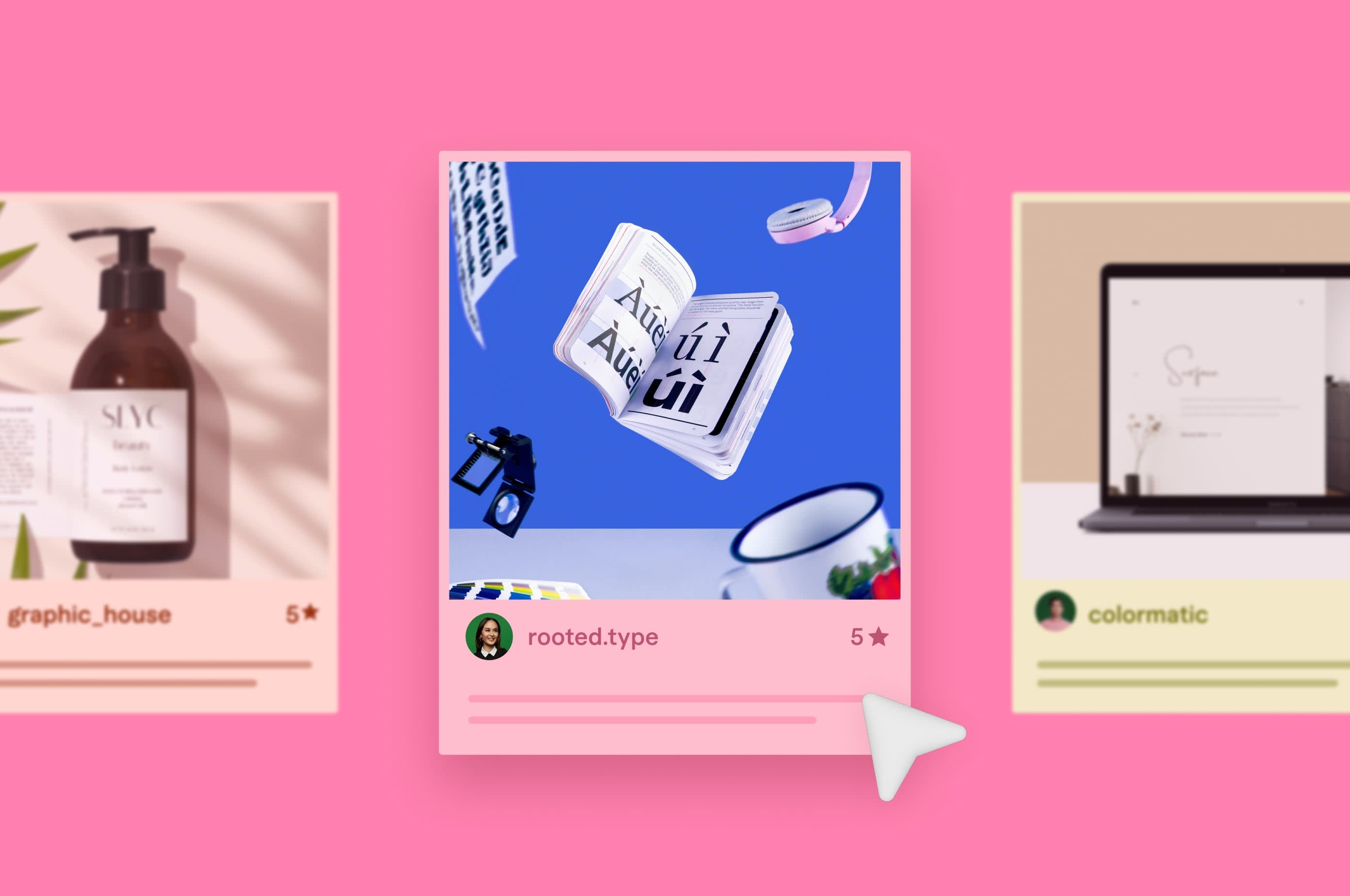11 best graphic design software and tips in 2023
Considering software options to enhance your graphic design skills? Discover 11 of the best graphic design software available now and how to pick the right one.
 August 27, 2023
August 27, 2023 11 minute reading
11 minute reading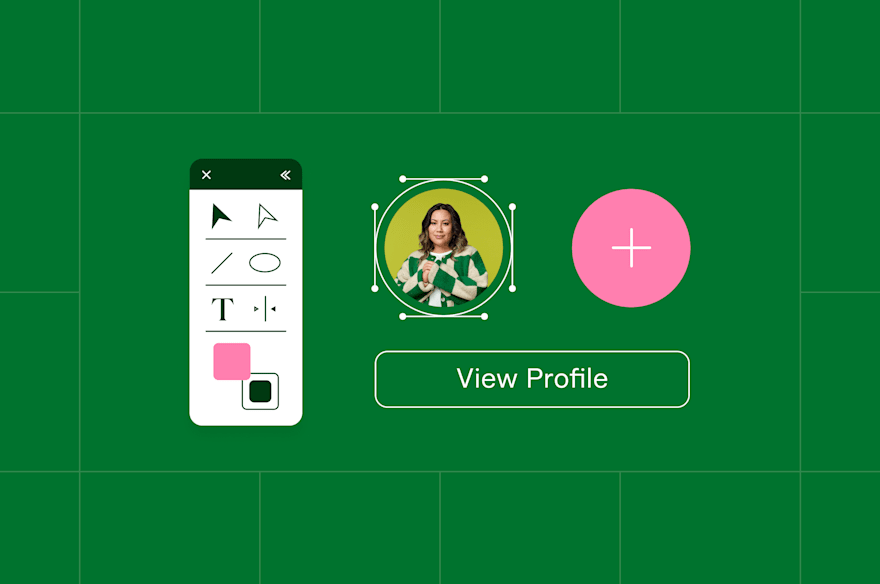
Graphic design is demanding work.
The good news: there are tons of capable tools that make the work more manageable.
Whether you’re designing brand identity assets, magazine layouts, social media graphics, or product packaging, there’s a tool that can help.
This guide covers the best graphic design software for creating stunning, stylish visuals, and how to pick the right tool for your needs.
Best graphic design software for different design needs
Look for a professional Graphic Designer on Fiverr
With many varying graphic design tools on the market, finding the right one is no easy task.
To help make your decision easier, we analyzed the top options based on different use cases and factors. Our selections also span a wide range of design needs, including raster image editing, typography, and vector design.
No matter your needs, skill level, or budget, check out the best graphic design software to find what works for you.
1. Adobe Creative Cloud: Best graphic design software
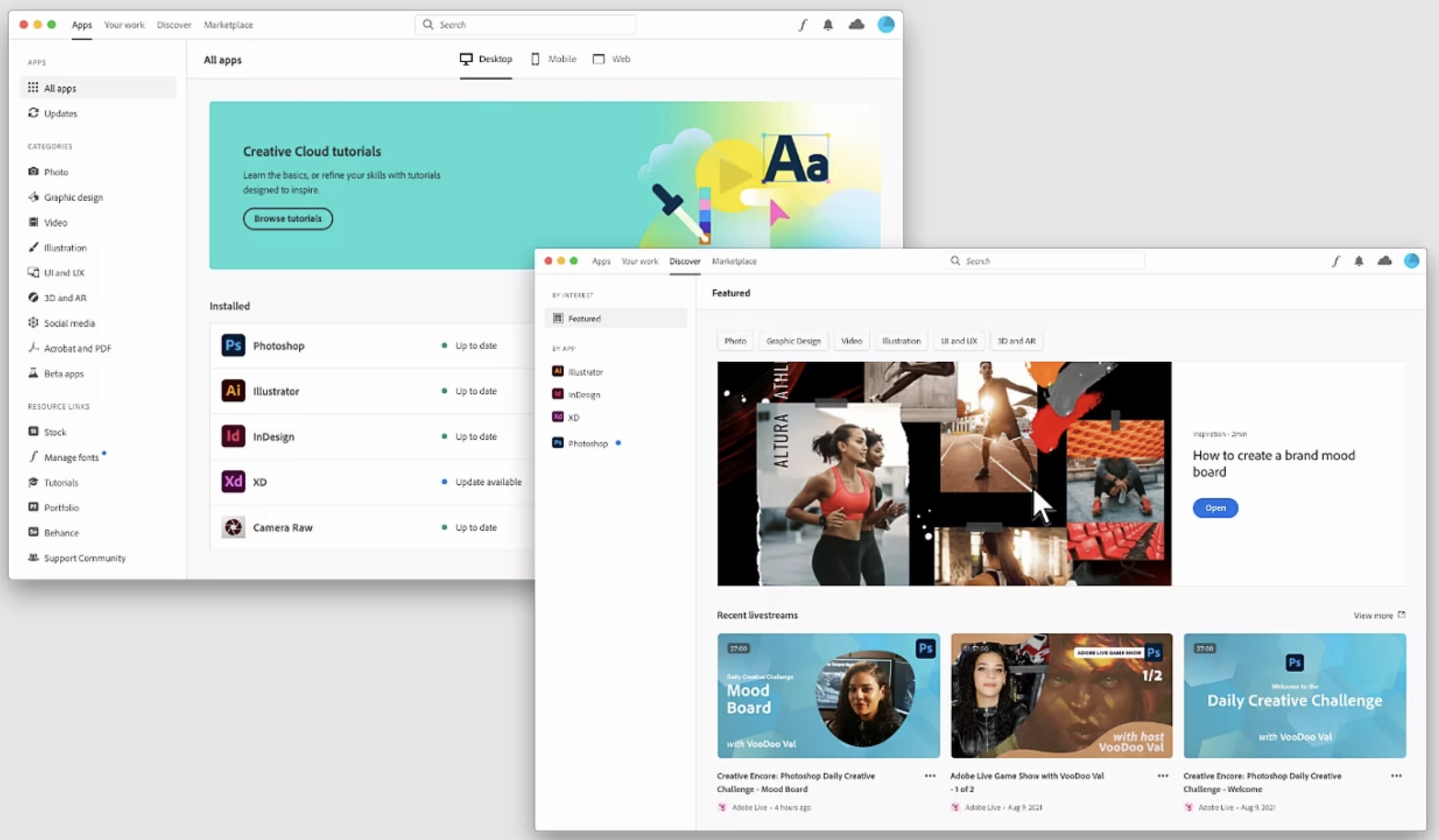
Source: Adobe Creative Cloud
Adobe Creative Cloud is a suite of tools with graphic design apps and services for photography, video, and the web.
The software suite includes thousands of quick how-tos, tutorials, and beautiful templates to make flyers, social posts, and stories. All these make the Creative Cloud ideal for beginners and experts.
With the full plan, you’ll get tools like Illustrator, InDesign, Photoshop, Adobe Spark, AfterEffects, Photoshop Sketch, and Premiere Pro. That way, you can explore your creativity and work more.
Creative Cloud works on multiple operating systems, such as Windows, MacOS, Android, and iOS.
Key features
Industry-leading graphic design tools
Cloud integration and collaboration features
Custom brushes
Adobe Fonts
Best-in-class templates
3D effects and textures
File portability between Adobe applications
short-format digital & print layouts
Pros
Integrates with other applications
Simplifies workflow and enhances productivity
Offers 100GB cloud storage
Comprehensive suite of powerful tools
Intuitive interface
Good performance
Cons
Can be expensive for individuals and small businesses
Some features can be complex and may require a learning curve
Pricing
Monthly plan: $82.49 per month
Annual plan: $54.99 per month
Annual prepaid plan: $599.88 per year
2. Canva: Best for beginners

Source: Canva
Canva is a free web design tool that offers professional, easy-to-customize templates for creating and editing podcast feature images, infographics, social media posts, posters, logos, or ads.
Canva’s drag-and-drop tool simplifies enhancing images, adding text to video, and other functions. With its photo editor, you can design, resize, and edit photos like a professional and take your content to the next level.
An image generator powered by artificial intelligence (AI) is also available, which creates beautiful images from text prompts.
Key features
Free stock images
Image enhancer
Photo blur
Text animations
Background remover
Design and photo grids
Free AI image generator
Collaboration tools
Social media integration
Photo filters
Saturation and tint
Pros
Free to get started
User-friendly interface
Huge library of assets
Over 250,000 drag-and-drop templates
Cons
Limited free plan
Can’t create unique design elements
Mobile app isn’t as intuitive or feature-rich as web version
Pricing
Free: $0
Pro: $6.49 per user, per month
Teams: $8.49 per month (for the first 5 people)
3. Adobe Photoshop: Best for digital image editing
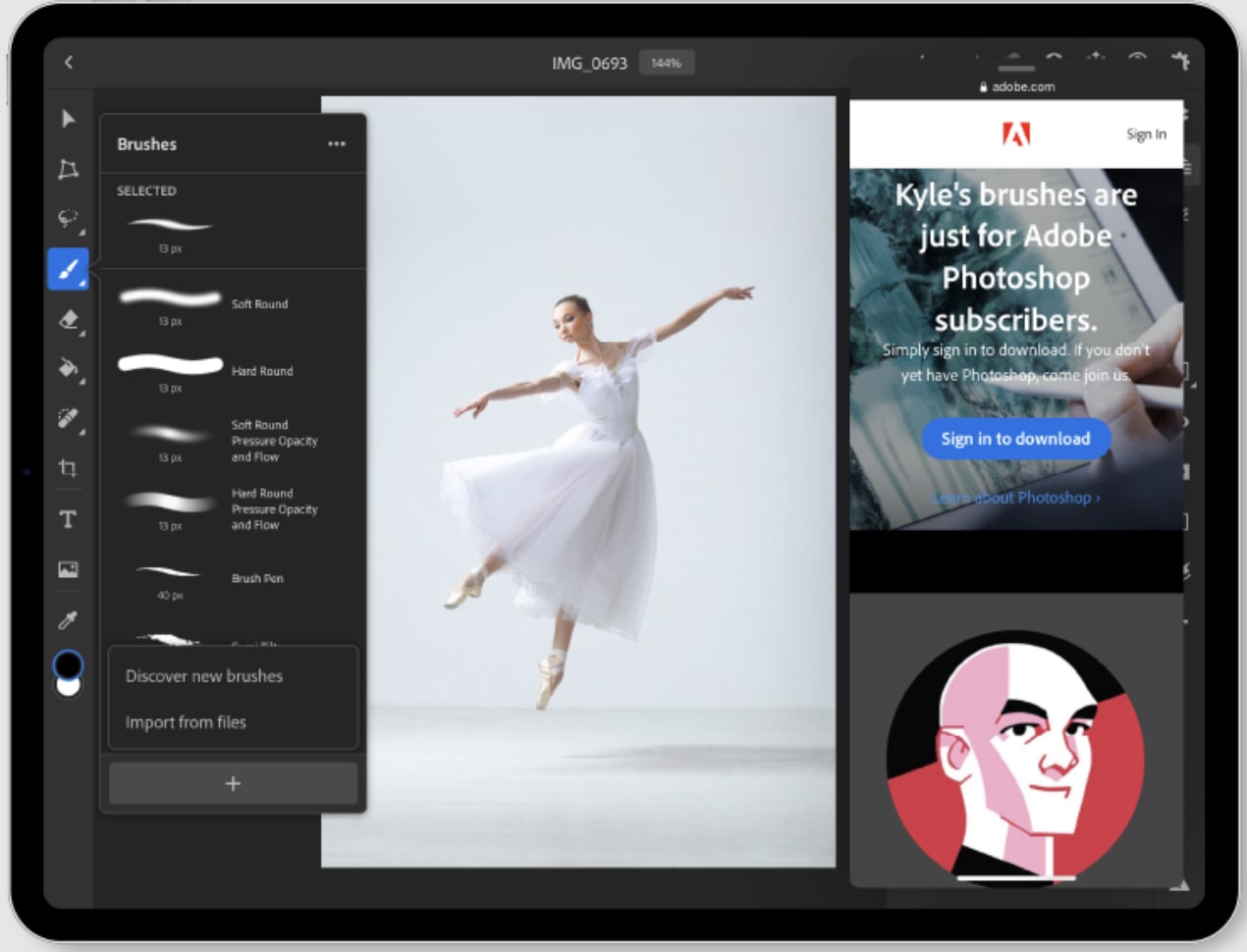
Source: Adobe Photoshop
Adobe Photoshop is the industry-standard for design software popular among professional graphic designers.
The software offers industry-leading tools, such as digital image editing, graphic design, and one-click transformations, and is ideal for creating or editing pixel-based or raster graphics, or working with photos.
You can create anything you imagine, including artistic effects and professional marketing content, combine multiple photos, and remove or transform photo elements. And if you need help, Photoshop’s Help content and in-app guided tutorials are available for you to learn as you create.
Key features
Complete customization tools
Pixel perfect precision
Custom brushes
Image layering (compositing)
Photo editing and transformation
Short-format digital & print layouts
Adobe Stock search to find graphic design elements
Easy collaboration and project sharing tools
Maximum control for refining and remixing photos
Nondestructive filters and tools
Machine learning technology for difficult tasks
Pros
Extensive library of stock photos, fonts, templates, icons, and videos
Intuitive editing features
Supports multiple file formats
Integrates with other Adobe programs
Cons
Expensive plans
Lacks 3D effects & textures
Resource-demanding
No long-format print and digital layouts
Pricing
Monthly: $31.49 per month
Yearly: $20.99 per month
Yearly: $239.88 per year (billed upfront)
4. Adobe Illustrator: Best for creating vector graphics

Source: Adobe Illustrator
With Adobe Illustrator, you can create gorgeous graphics, such as business logos, web graphics, and packaging designs that work anywhere.
The software is ideal for creating graphics you can infinitely scale up or down without losing sharpness or blurring, in small, extra-large, print, or digital format.
You can combine shapes, types, and colors to make unique graphics to make your brand pop in mobile apps, packaging, and signage to bring your products to market in style. Its Generative Recolor (in beta form) is useful for turning words and concepts into color palettes and applying them to your designs.
Illustrator is also useful for creating infographics from complex data, making it easier to see trends, discover insights, and make smart business decisions. Also included is Vector Recoloring—an AI feature that generates vector image variations in different color schemes so you can pick the best version for your project.
Key features
Repeat for Patterns or Global Edits
Shape Builder
Vector Recoloring (AI tool)
Review link for collaboration
Built-in tutorials, tool guides, and creative inspiration
Intertwine for text and objects
Pros
Wide range of vector design tools
Multi-format support
Integration with other Adobe tools
Cons
Expensive
Resource-demanding
Steep learning curve
Pricing
Monthly: $31.49 per month
Yearly: $20.99 per month
Yearly: $239.88 per year (billed upfront)
5. Affinity Designer: Best for professional designers
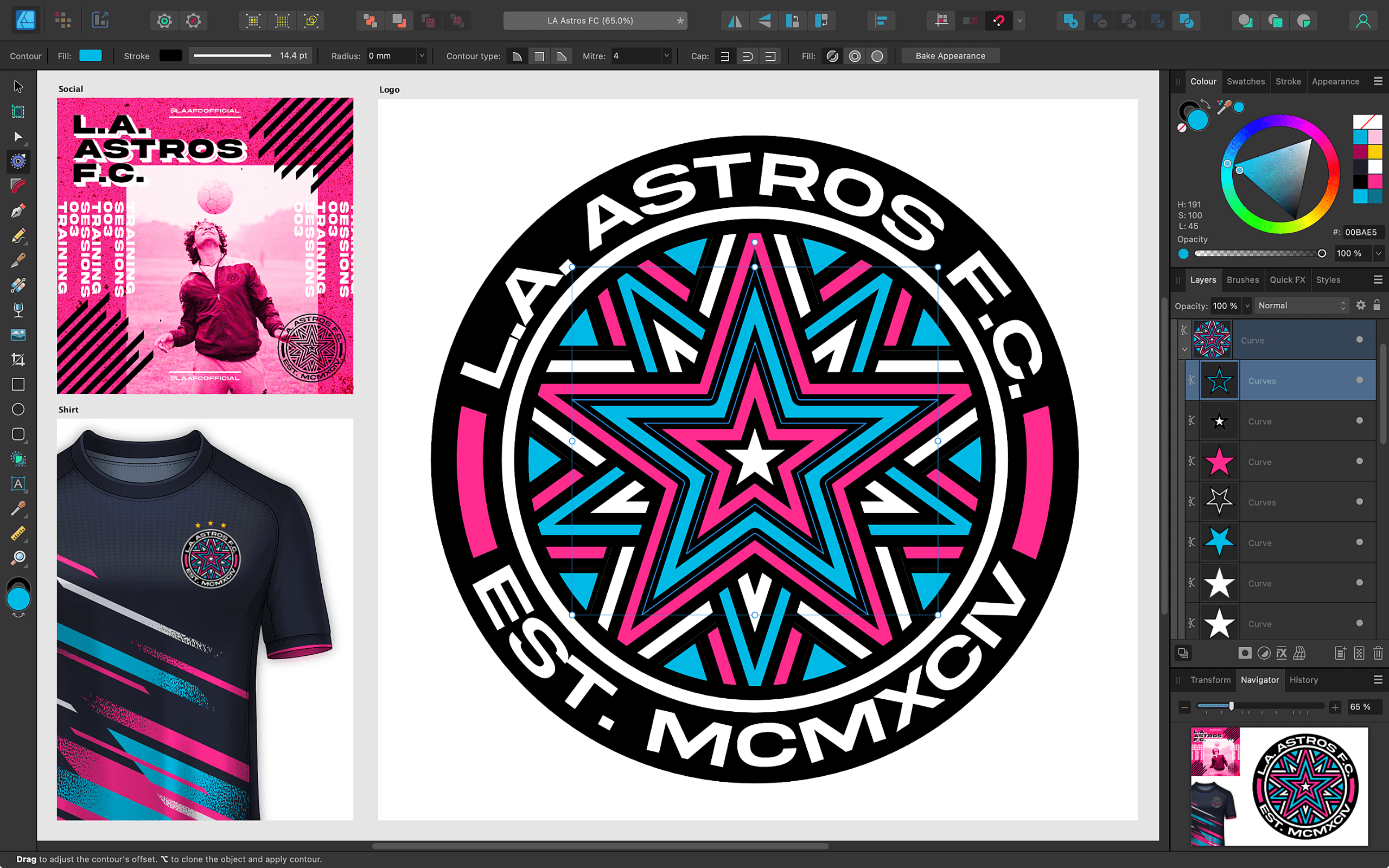
Source: Affinity Designer
Need professional graphic design output for print, digital, or collaboration? Affinity Designer—a vector graphics software—is worth considering.
The software offers a similar suite of graphic design tools like Adobe Illustrator, along with advanced features for vector and raster graphics. These enable professional illustrators, web designers, and other creatives to create unique graphics, high-quality print projects, mockups, user interface (UI) designs, video art, and concept art.
Too busy to learn graphic design software? Buy the services of an AI video artist for your next project.
Key features
Layer groups
Color tagging
Live outline view
Intuitive user interface
Fully featured vector and raster workspaces
Custom brushes
Grids, guides, and planes
Pixel preview mode
Unlimited artboards
Sophisticated typography options
Detailed version history
Pros
Live, responsive, and fast
Versatile
Works with multiple devices
Multiple file format support
Budget-friendly one-off payment
Cons
Steep learning curve
No cloud service
Pricing
Affinity Designer (version 1): $ (one-off)
Affinity Designer (version 2): $52.99 (one-off)
Affinity V2 Universal Licence: $123.99 (one-off)
6. Figma: Best for UI design
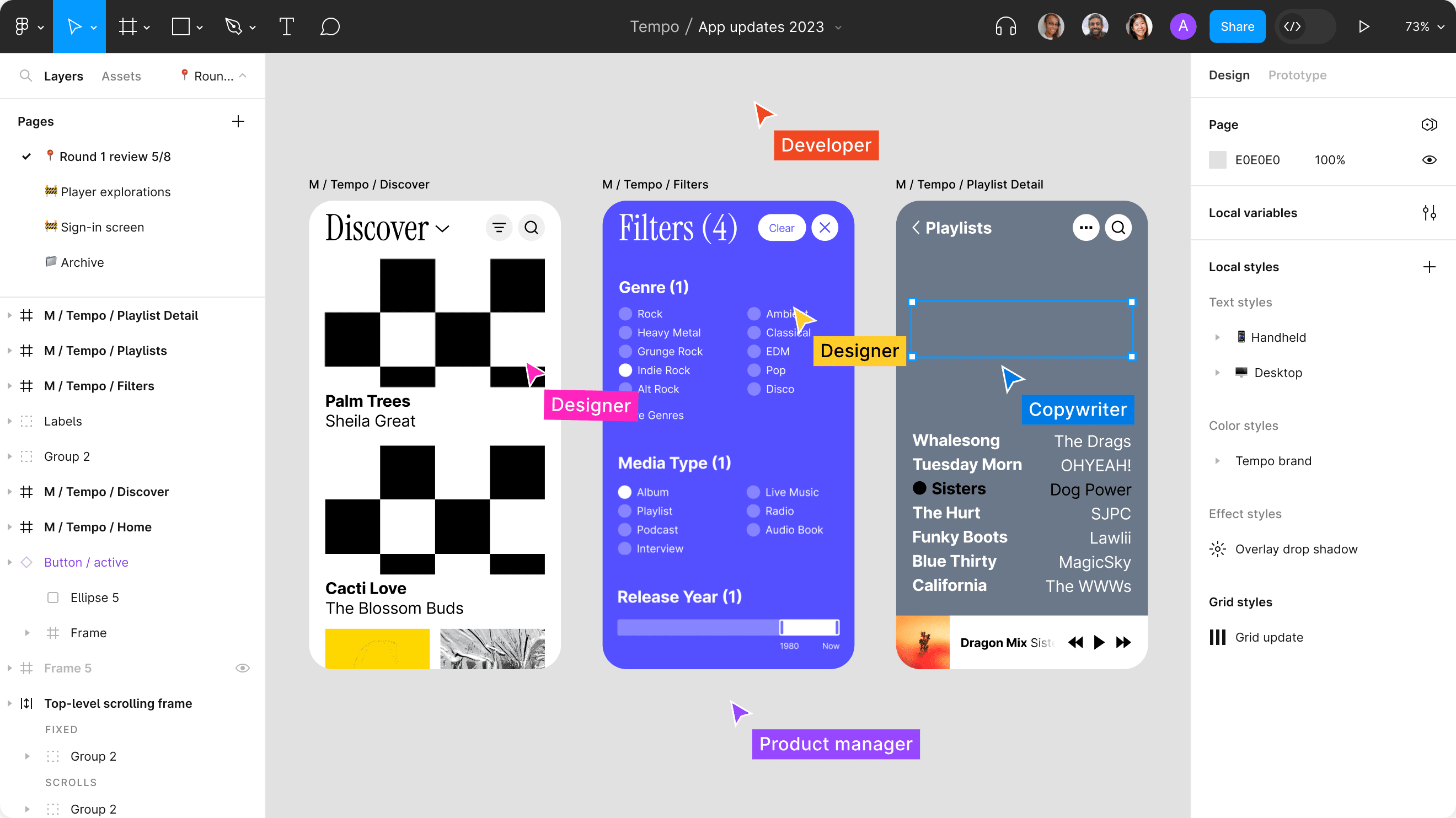
Source: Figma
Figma is an online design tool for creating, sharing, and testing digital art designs for mobile apps, websites, and other assets.
The software is flexible for use by solo designers and teams, allowing multiple people to work and collaborate on the same project. It allows everyone to contribute and share feedback in real-time and asynchronously.
Your work is always backed up so you won’t have to keep saving or creating multiple versions.
Key features
Auto layout
Pre-loaded frames
Collaboration tools
Sections and pages
Branching and merging
Intuitive interface
Smart select
OpenType and variable fonts
Plugins and widgets for task automation
Dev Mode
Pros
Free plan available
Cloud-based tool
Lightweight and fast
Doesn’t need to be installed to use or share files
Auto-saves your work
Cons
Steep learning curve
Lacks enhanced typography for consistent designs
No offline mode
Limited customization options
Few animation capabilities
Limited third-party integrations
Pricing
Free: $0
Professional: $12 per editor, per month
Organization: $45 per editor, per month
Enterprise: $75 per editor, per month
7. Adobe InDesign: Best for desktop publishing
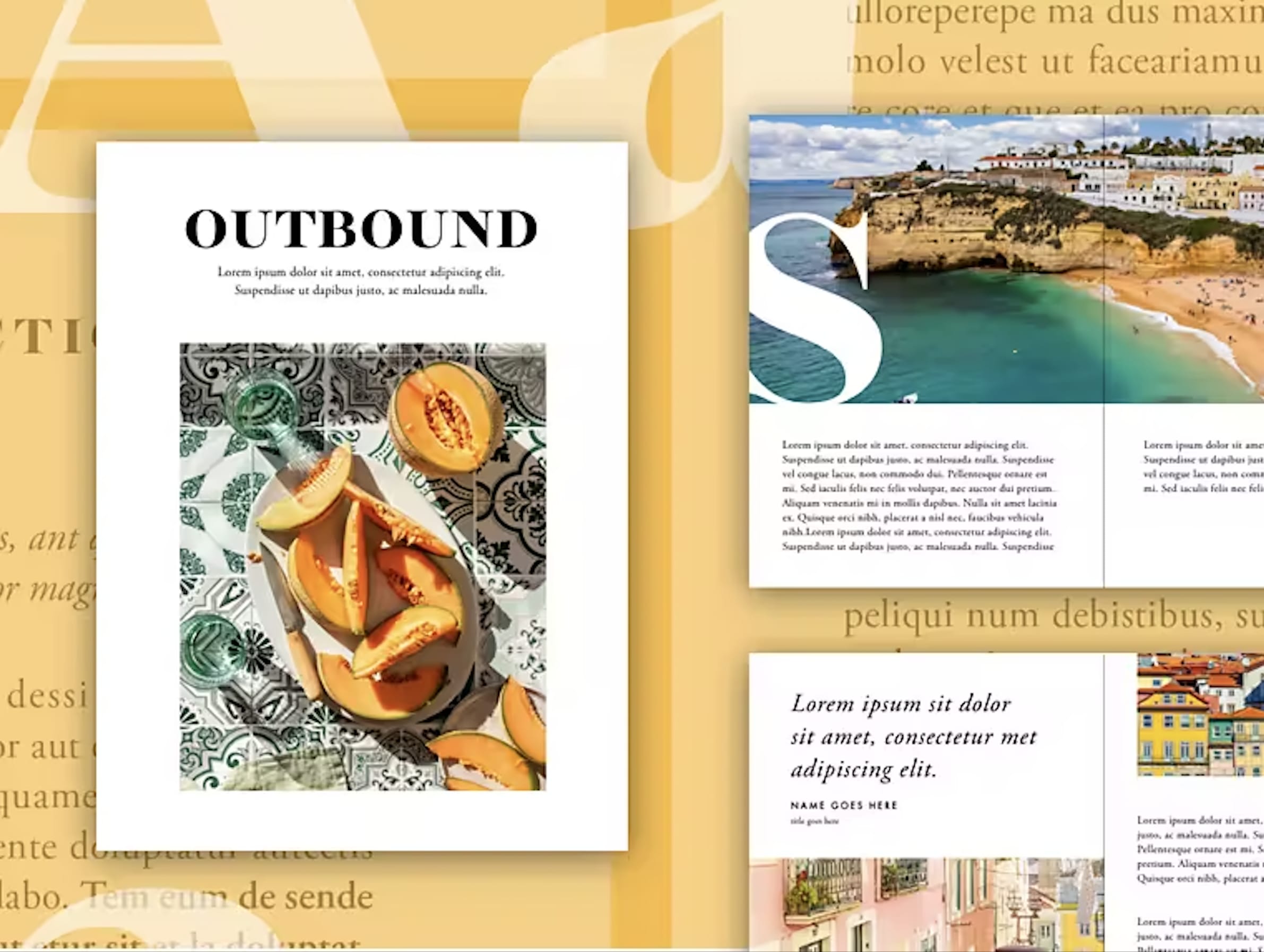
Source: Adobe InDesign
Want to create and publish books, posters, ebooks, interactive PDFs, or digital magazines? Adobe InDesign offers everything you need to create presentations, documents, and image-heavy posters.
The standalone desktop publishing program works with other Adobe programs and lets you create a house style for your graphic design needs. This saves you time and effort instead of switching between multiple tools.
You’ll also find a wide range of useful graphic design tools plus collaboration features to speed up the design review process.
Key features
Layout and typesetting tools
Cloud documents
Auto Style
Seamless copy and paste
Modern graphics support (HEIC, JP2K and WebP images)
Pros
Standout layouts for any output
Keeps everything organized
Built for collaboration
Good for image-heavy designs
Cons
Expensive
Steep learning curve
Pricing
Monthly: $36.21 per month
Yearly: $24.14 per month
Yearly: $275.86 per year (billed upfront)
8. Inkscape: Best free graphic design software

Source: Inkscape
Inkscape is a free, open-source design tool for creating vector images, taking them from raw drafts to a final, professional-grade design format.
The software is flexible and used by individual designers or companies in various industries. You can create graphic design projects in Inkscape and export them in friendly formats for publication in physical form or on the web.
Plus, Inkscape is cross-platform, so you can run it easily on Windows, Linux, and MacOS devices, such as iPad.
Key features
Flexible text, shaping, and drawing tools
Transformation tools
Layers and grouping objects
Color selector and picker tool
Copy and paste style
Dashed strokes
Pattern fills (vectors/bitmaps)
Node editing
Boolean operations
Kerning, line spacing, and letter spacing adjustments
Alpha transparency support
Broad file format compatibility
Command line options for export and conversions
Pros
Free to use
Multiple customization options
Works with SVG file format
Can be incorporated into other programs
Can import AI and CorelDRAW files
Cross-platform compatibility
Cons
Sluggish controls
UI isn’t as intuitive
Pricing
Free
9. GIMP: Best for raster graphics
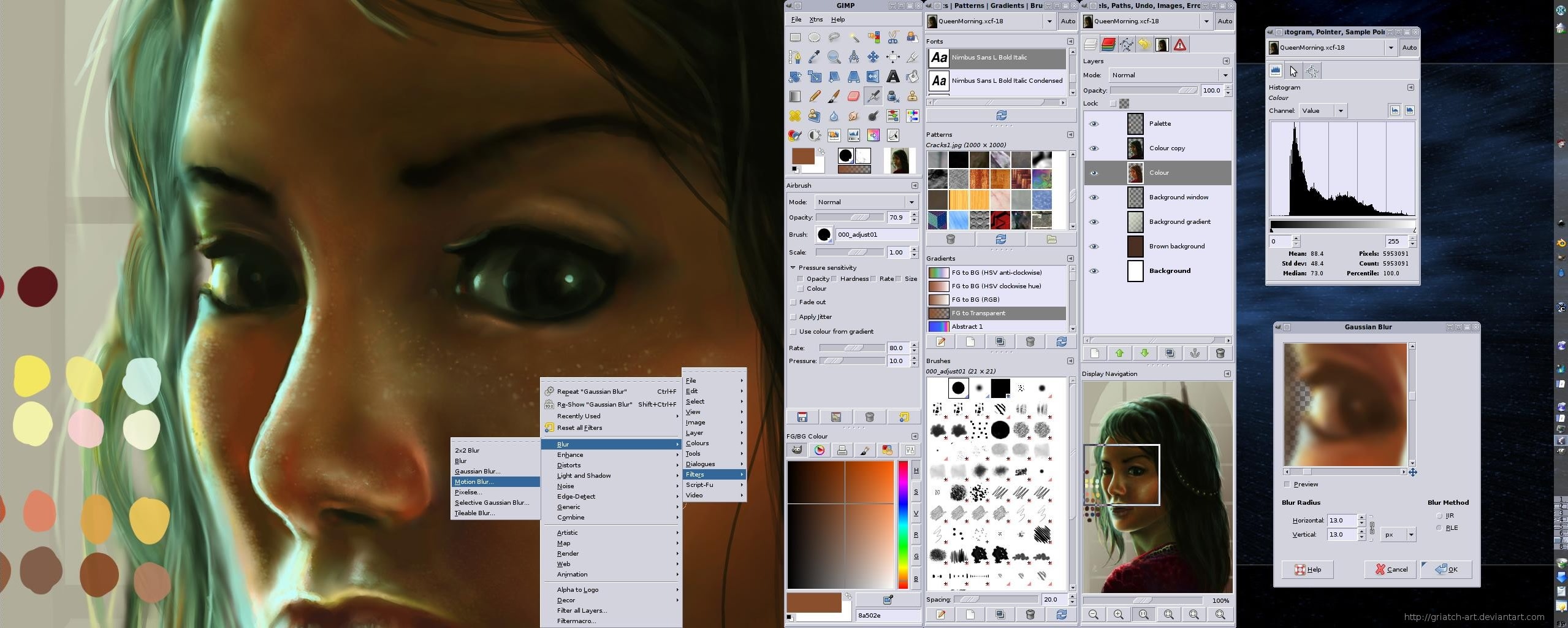
Source: GIMP
Like Inkscape, GIMP—GNU Image Manipulation Program—is a free and open-source program for creating unique graphic designs.
GIMP is the most comprehensive graphic design software for creating or editing raster graphics. The program—often compared to Adobe Photoshop—helps advanced designers looking for a custom tool create graphics and illustrations.
The software provides customization options, an impressive image editor, and support for digital retouching, multiple file formats, and quick design creation. Plus, you get multiple third-party plugins to enhance your design capabilities and productivity.
Key features
Customizable interface
Digital retouching
Powerful image editing tools
User-friendly navigation
Top-notch color management
Pros
Offers similar functionality to Photoshop for free
Lightweight compared to other programs
Outstanding, helpful support
Robust and feature-rich
Frequently updated
Multi-language support (C, C++, Perl, Python, Scheme, and more)
Cons
Steep learning curve
Pricing
Free
10. CorelDRAW: Best for all-in-one illustration

Source: CorelDRAW
CorelDRAW is a top choice among graphic design professionals for its advanced illustration capabilities, precise design, and easy-to-use collaboration tools.
Whether you’re an occasional graphics user or just starting out, a graphics enthusiast, or a designer looking for the latest and advanced tools, CorelDRAW offers graphic design options for all skill levels.
Key features
Vector illustration tools
Collaboration tools
Scaling tools
Objects and color styles
Automation support
Enhanced color management
Multiple file format support
Pros
Pro-level features
Easier to learn than Illustrator
Highly customizable interface
Cons
No AI features
Lacks many shortcuts other competitors offer
No smooth transition between pixel and vector-based designing
Pricing
Free: $0
CorelDRAW Graphics Suite: $859 (one-time) or $36.58 per month
CorelDRAW Standard:$419.00 (one-time)
CorelDRAW Essentials: $155.00 (one-time)
11. Sketch: Best for Mac users

Source: Sketch
Sketch is a complete design platform with an intuitive interface that doesn’t interrupt your flow and thoughtful features that make mundane tasks simple.
Built as a Mac app (which can be a dealbreaker for Microsoft users) Sketch lets you create designs, build prototypes, team up, and do more within your design workflow.
The web version of the software offers collaboration tools so everyone on your team can browse, contribute, give feedback, inspect, and handoff—regardless of the browser they use.
Key features
Vector editing
Intuitive prototyping
Shared styles, components, and libraries
Color profile control
OpenType and variable font support
Reusable design templates
Offline and local file support
Drag-and-drop between apps
File organization
Customizable shortcuts
Artboard templates
Pros
Works in any browser
Offers workspaces for collaboration
User-friendly interface
Strong community support
Cons
Mac-only use
Lacks version comparison
Pricing
Standard: $12 per editor, per month
Business: $20 per editor, per month (billed yearly)
Mac-only license: $120 per license
What to look for in graphic design software for your business
Most of the tools on this list are available on desktop, mobile, and web platforms, but is there a distinct benefit to choosing one over the other?
Not really. You’ll get similar functionality for creating graphic designs, but the best choice for your needs depends on several factors.
Here's what to consider when picking the best graphic design software for your business:
Features: Find software that offers the features necessary for your design needs. For instance, Adobe Photoshop may be the best photo editing software while InDesign may work for laying out print publications and similar artwork types.
Cost/budget: Some tools offer a free version or free trial while others come with different pricing structures with varied feature sets. Compare this with your needs and budget to avoid overpaying for a tool just because it’s popular.
Usability: Based on your needs, determine whether the tool can create the actual designs you’re looking for and how you can export and share the files without compromising quality.
Precision: Ultimately, you want a tool that delivers graphics with high degree precision regardless of the type or size. The tool you’re considering should ensure your designs look their best and be as clean as possible without missing details or blurred pixels.
Templates and tools: When choosing a graphic design software, consider one that offers a wide range of templates for your industry or design needs. That way, you can streamline your projects and manage tasks easily and quickly.
Platform: Find a tool that can work with the platform you’re familiar with, whether that’s Windows, Mac, Linux, Android, or iOS.
Skill level: Pick a tool with an intuitive user interface that doesn’t have a steep learning curve for your skill level. If you’re new to photo editing, pick a beginner-friendly tool to get started, then move to a more complex one as you upgrade your skills.
Collaboration: If you have a team, pick a tool that makes collaboration, review, and sharing easier and provides version history.
Create striking visuals
Graphic design tools make designing stunning and stylish graphics easier and quicker.
While these are 11 popular choices for individuals and businesses, there are many more out there. Ultimately, the one you pick should be a good fit for your workflow and team. Give each a spin using the available free trial or free versions to find what works best for you.
Look for a professional Graphic Designer on Fiverr
If you need expert design work for your upcoming project, you can find top professional graphic design freelancers on Fiverr to deliver visual value for your business.
Fiverr is a leading digital marketplace for a wide range of expert graphic design services, including web design, app design, AI art, and more. The best part is you can manage all your projects, freelancers, and payments on the platform for free.
Sign up for Fiverr to find freelance graphic design services for your next project.
